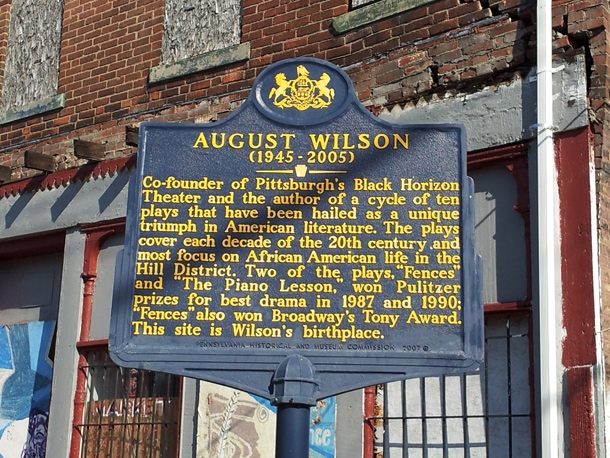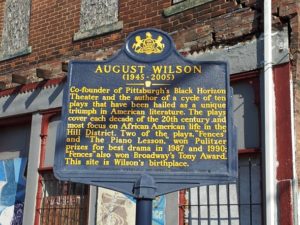

August Wilson wrote about African American life, and he received two Pulitzer Prizes for Drama.
Madeline Bartos | Staff Writer
02/08/2018
CORRECTION: An earlier version of this article incorrectly states that The August Wilson Center is owned by the Pittsburgh Cultural Trust. It has been updated to rectify this mistake.
From the 1920s to 1940s, the Hill District was a place of thriving culture, producing some of the highest literature, art, jazz and a vibrant nightlife. Just down the street from Duquesne University, the Hill District helped shape Pittsburgh’s modern heritage.
“The Hill District’s culture has been vital to the making of modern Pittsburgh and the United States,” said Andrew Simpson, a history professor at Duquesne whose research includes local history.
The Hill District of today is radically different than the one of the past. According to Pittsburgh Magazine, the desire for urban renewal devastated the Lower Hill. In order to build the Civic Arena, 8,000 people and 400 businesses were displaced as the city knocked down empty buildings instead of investing money for renovations or finding people for maintenance.
Before the Lower Hill was razed, it was a center for African American culture. During World War I, steel mills were on the rise, but most of America’s men had gone to fight in the war. The Hill Community Development Corporation said this need for labor played a part in fueling the Great Migration, and recently-relocated African Americans settled in the Hill District.
One of the most prominent figures from the Hill District was playwright August Wilson. Wilson wrote a collection of 10 plays called the Pittsburgh Cycle, a collection that features the fictional stories of African American Pittsburghers throughout the 19th century.
“In the case of Wilson, the Hill provided an important backdrop for many of his stories, which brought national attention to the neighborhood and the struggles faced by African Americans in our city,” Simpson said.
Wilson’s legacy remains strong in this city. The August Wilson Center, for example, celebrates Wilson and his talent.The August Wilson Center aims to “illustrate the artists and performers that are collaborating with the Pittsburgh Cultural Trust to tell a new story,” according to the Cultural District’s website.
Wilson’s home in the Hill can be found at 1727 Bedford Ave. The Daisy Wilson Artist Community, a nonprofit corporation, “intends to transform the August Wilson Home into studio space for the fine arts, music and literature; to explore the cultural narrative of the plays of August Wilson … to encourage and support educational and artistic activities to enrich the Hill District and surrounding community,” according to its website.
While Wilson’s impact has stretched far beyond Pittsburgh, he was just one of the many influential movers and shakers of the Hill District. The region was also known for its exceptional jazz scene, with the Hill Community Development Corporation describing the Hill as becoming nationally “known on the burgeoning jazz circuit because it was home to legendary jazz giants.”
To name a few, Billy Eckstine, Earl Hines and Lena Horne were some of the famous jazz musicians to gain their fame in the Hill District. The nightlife attracted jazz musicians and listeners alike, making it a center for the art.
Another influential voice coming from the Hill District was the African American newspaper the Pittsburgh Courier. The Courier aimed to inform and empower African Americans so they could make political and economic changes to better its community.
The Pittsburgh Courier, based in the Hill, also played an important role in combating discrimination during World War II with the Double V for Victory Campaign and gave African Americans in Pittsburgh, through their reporting and editorials, a national voice in politics,” Simpson said.
While the Hill District is no longer the bustling center of cultural activity that it used to be, groups and organizations like the Hill Community Development Corporation are starting “a swirling renaissance or renewal, rehabilitation, restoration and revitalization.”
“The Hill, like many other Pittsburgh neighborhoods, has been challenged by the transition from an industrial to a post-industrial economy,” Simpson said. “What makes the Hill unique is that residents have also had to find ways to manage the results of urban renewal projects that severed the Lower Hill from Downtown and displaced numerous families throughout the neighborhood.”
The Daisy Wilson Artist Community calls Pittsburgh to action to restore Wilson’s home. On its website, the organization list three reasons for Pittsburgh to care: “Reintroducing arts will revitalize the culture of Pittsburgh’s Hill District,” “the house will help preserve August Wilson’s legacy and philosophy” and “academic initiatives will ensure the partnership’s continuity and emphasize community building as two neighbors working together for a common cause.”




